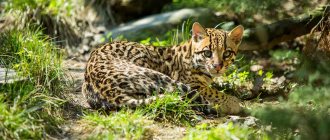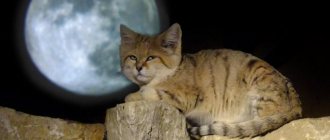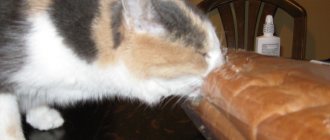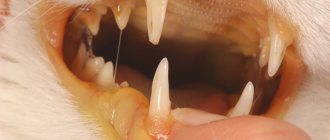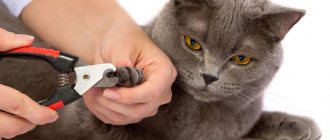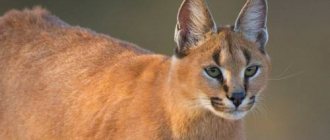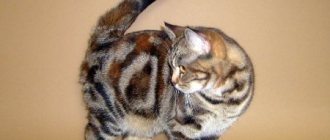- Wild animals
- >>
- Mammals
The Caracal is a cute cat with a streamlined, sleek body, short, golden-reddish fur and distinctive facial markings. These are one of the most beautiful species of wild cats on Earth, also called the desert lynx. Caracals have no spots or stripes, and they have longer legs and a slimmer body than the true lynx.
They are the heaviest and also the fastest of the small cats in Africa. The anatomical adaptations that give the caracal its extraordinary beauty and athleticism are the result of 35 million years of felid evolution.
Origin of the species and description
Photo: Karakal
The caracal's place in the cat family tree is somewhat confusing, but it is believed to be directly related to the serval and golden cat. The caracal's habitat is different from its feline cousins. Servals and caracals are similar in size, however servals hunt in wet habitats while caracals stick to drier areas.
origin of name
Now that the reader knows about the appearance of the caracal and the place where it lives, he may be interested in where such a strange name came from. In fact, everything is simple here.
The name came into the Russian language from the Turkic languages - Turkish, Kyrgyz, Kazakh. Now it is difficult to say exactly which people gave the usual name to this beast. After all, from all of the above languages, “karakulak” is translated as “black-eared” or “black ear” - as mentioned above, the outer side of the ears of a sand animal is precisely black in color. Apparently, Russian settlers or soldiers simply simplified it to the more easily pronounced caracal.
Moreover, this word has taken root not only in the Russian language, but also in almost all European languages. After all, even in Latin the beast is called nothing more than caracal.
Video: Caracal
Adaptation and diversity of prey in different habitats and areas of different sizes indicate that the caracal is not endangered as a species. The results of phylogenetic studies show that the caracal and the African golden cat (C. aurata) diverged in their development between 2.93 and 1.19 million years ago. These two species, together with the serval, form the Caracal genetic line, which in turn dispersed between 11.56 and 6.66 million years ago. The ancestor of this lineage arrived in Africa somewhere between 8.5 and 5.6 million years ago.
"Felis caracal" is the scientific name used by Johann Daniel von Schreber in 1776, who described the skin of the cheetah from the Cape of Good Hope. In 1843, British zoologist John Gray placed it in the genus Caracal. It is placed in the family Felidae and subfamily Felinae. In the 19th and 20th centuries, several individuals of the caracal were described and proposed as a subspecies.
Since 2021, three subspecies have been recognized by scientists as valid:
- southern caracal (C. Caracal) - found in Southern and Eastern Africa;
- northern caracal (C. Nubicus) - found in North and West Africa;
- Asian caracal (C. Schmitzi) - found in Asia.
The name "caracal" consists of two Turkic words: kara, meaning black, and kulak, meaning ear. The first recorded use of this name dates back to 1760. An alternative name is Persian lynx. The Greeks and Romans most likely applied the name "lynx" to caracals. This name is sometimes still applied to the caracal, but the modern lynx is a separate species.
Maintenance and care
Caring for a pet caracal is not that difficult. You won't need to brush or bathe your pet regularly. Caracals cannot be kept outside in our conditions. These animals love warmth very much, so prepare a special soft place for your pet where he can rest and warm up.
If you want your cat to become a reliable friend, I recommend adopting a kitten under the age of six months - this way he can quickly get used to his new owners and home. Under no circumstances should you keep rodents or birds at home with a caracal - most likely he will consider them prey.
Like all representatives of the cat family, the Caracal cat loves to climb to heights. It is better to arrange special shelves for this.
If the animal lives in an apartment, it is advisable to walk it regularly. For these purposes, use a leash - otherwise the caracal may run away or harm other people and animals. By the way, if you go to a too crowded place, I also recommend taking a muzzle. This breed can be quite aggressive towards strangers.
Appearance and features
Photo: Caracal animal
The caracal is a slender cat characterized by a strong build, short face, long dog-like teeth, tufted ears and long legs. It has brown or red fur, the color of which varies among individuals. Females are lighter than males. Their undersides are white and, like the African golden cat, decorated with many small spots. The fur itself, soft, short and dense, becomes coarser in summer.
The ground hair (the main layer of hair covering the coat) is denser in winter than in summer. The length of the guard hairs can reach 3 cm in winter, but shorten to 2 cm in summer. There are black markings on the face: on the whisker pads, around the eyes, above the eyes and slightly down the center of the head and nose.
A distinctive feature of caracals is the elongated, black tufts above the ears in the form of tassels. There are many theories about their purpose. Tufts can keep flies away from a cat's face or help camouflage themselves in long grass to break up the outline of the head. But, the most common version is that the cat moves its ear tufts when communicating with other caracals.
The legs are quite long. The hind legs are disproportionately high and muscular. The tail is short. Eye color varies from golden or copper to gray or green. Melanistic individuals have been recorded but are extremely rare.
Juveniles are distinguished by shorter ear tufts and blue tinted eyes. The C. caracal subspecies may not differ in phenotype. Females are smaller and weigh up to 13 kg, while males can weigh up to 20 kg. The tail is shortened, but it still makes up a significant part of the total body length. The length of the tail varies from 18 cm to 34 cm. The length of the head and body from the nose to the base of the tail ranges from 62 to 91 cm. Even the most miniature adult caracal is larger than most domestic cats.
The right diet
A very important aspect in keeping an unusual pet is the caracal’s nutrition. Fortunately, you won’t need too complex or exotic products here.
The domesticated caracal happily eats almost any meat product. For example, he does not refuse rabbits, gophers and other rodents. He enjoys eating beef and chicken, including boiled chicken. It would be a good idea to include fish in your diet - sea fish can be given raw, but freshwater fish must be cooked to ensure that the eggs of parasites are destroyed.
Also, do not forget to give your pet minerals and vitamins. You can dissolve them in water or simply mix them with meat.
But it is not advisable to feed a caracal pork. Fatty meat can lead to serious obesity - the animal moves little and may develop health problems over time.
Where does the caracal live?
Photo: Caracal cat
The caracal's habitat extends through Africa through the Middle East all the way to India. It is perfectly adapted to the harsh everyday life in the savannah, dry forest, semi-desert, arid hilly steppe and dry mountains. In Africa, the caracal is widespread in sub-Saharan Africa, but is considered rare in North Africa. In Asia, its range stretches from the Arabian Peninsula, along the Middle East, Turkmenistan, Uzbekistan to western India.
The population is disappearing in North Africa, but there are still many caracals in other African regions. Their settlement limits are the Sahara Desert and the equatorial forest belt of Western and Central Africa. In South Africa and Namibia, C. caracal is so numerous that it is exterminated as a nuisance. Asian populations are less numerous than African ones.
Interesting fact: Caracals were once trained to hunt birds in Iran and India. They were placed in an arena containing a flock of pigeons, and bets were placed on how many birds the cat could kill in one jump.
The species inhabits forests, savannas, swampy lowlands, semi-deserts and scrub forests, but prefers arid areas with little rainfall and shelter. In mountainous habitats, this occurs at an altitude of up to 3000 m. A dry climate with limited leaf cover is preferable for the animal. Compared to servals, caracals can tolerate much drier conditions. However, they rarely inhabit deserts or tropical areas. In Asia, caracals are sometimes found in forests, which is not typical for African populations.
In Benin's Pendjari National Park, the movement of caracals was recorded by camera traps. In the Emirate of Abu Dhabi, a male caracal was discovered using camera traps in Jebel Hafeet National Park in February 2021, the first time since 1984. In Uzbekistan, the caracal has only been recorded in the desert areas of the Ustyurt Plateau and the Kyzylkum Desert. Between 2000 and 2021, 15 individuals have been spotted alive and at least 11 have been killed by herders.
Caracal (steppe lynx). Photo and video.
The caracal (steppe lynx) is a predator, a mammal of the cat family. For a long time, the caracal was classified as a lynx, since it resembles them in appearance, but after a series of genetic studies it was separated into a separate genus. But still, caracals are closer to lynxes than other cats.
In appearance, the caracal resembles a lynx, only smaller in size, more slender and with a uniform coat color. Body length is 65-82 cm, tail – 25-30 cm, height – approximately 45 cm, weight – 11-19 kg. There are tassels up to 5 cm long at the tips of the ears.
On the paw pads there is a brush made of hard hair, which makes it easier to move through the sand. Well, in general, the size of a caracal does not exceed the size of an ordinary cocker spaniel dog.
The fur is thick and short. In color, the caracal is similar to the North American puma - brown-red fur on top, whitish below, there are black markings on the side of the muzzle. The tassels and ears are black on the outside.
Melanistic caracals with black fur are extremely rare. The color of an animal's fur is largely influenced by its habitat and hunting location. For example, the Israeli caracal has a much paler coat than the one living in India, and some Iranian species have black fur and silver tassels on the ears.
In some African countries, these animals are called “red cats” for their copper-colored fur, in some – “gazelle cats” for their extraordinary mobility and lightness.
Although the caracal is similar in appearance to a lynx, morphologically it is closer to the puma. Also close to it is the African serval, with which the caracal easily interbreeds in captivity.
At first glance, the caracal's face is very similar to that of a cat. The only difference is the large triangular ears, topped with long black tassels. In young caracals, the tassels are almost in a vertical position, but over time their elasticity is lost, and they begin to hang from the ears like ribbons.
Just don’t be impressed by its good looks and small size. Caracals are strong and dangerous predators, far-sighted and experienced hunters, capable of pursuing prey whose weight is twice its own weight.
It pierces the throat of its prey with sharp fangs, and holds it with its powerful jaws so that the prey does not escape from its pursuer. The claws and molars are sharp, like blades, with which the caracal cuts prey and separates the meat from the tendons.
The most powerful weapon of this animal can be called its hind legs, muscular and strong, which even an Olympic-level jumper or sprinter would envy. They give the caracal amazing agility. Also, these animals have well-developed hearing, being unusually acute, they see perfectly in the dark.
Amazing ears, controlled by twenty muscles, help the caracal hear the noise of an approaching victim when the night is dark all around. There are many hairs inside the ear, which help determine the location of prey as accurately as possible.
The name “caracal” comes from the Turkish word “karakulak” - “black ear”. The explanation for this name is the black back of the ears of caracals. The population of North Africa calls the karcal "Barbary lynx."
Caracals are found in deserts, savannas, foothills of Africa, deserts of Central and Asia Minor, and the Arabian Peninsula. Also, these animals can be found, only infrequently, in the desert of Southern Turkmenistan, on the coast of the Caspian Sea (up to the Mangyshlak Peninsula), and occasionally found in Uzbekistan, in the Bukhara region.
Different subspecies of caracals are common in different areas:
· In South Africa and Sudan – Caracalcaracalcaracal.
· In North Africa – Caracalcaracalalgira.
· In Namibia – Caracal caracal damarensis.
· In Botswana – Caracal caracal limpopoensis.
· In Gabon – Caracal caracal luciani.
· In Turkmenistan – Caracal caracal michaelis (Turkmen caracal). This subspecies is endangered, the total number of remaining individuals is no more than 300.
· In Ethiopia and Sudan – Caracalcaracalnubica.
· In Nigeria – Caracal caracal poecilictis.
· From Anterior India to Arabia - Caracalcaracalschmitzi (Indian caracal).
Caracals are active mainly at night, but in winter and spring they can also be found during the day. These animals choose fox or porcupine burrows and rock crevices as their shelters. Caracals can live in one shelter for several years.
The territories occupied by males have a large area, while females get smaller areas on the periphery.
The long legs of the caracal allow it to jump up to 4.5 m in length, which it actively uses when hunting, but it cannot run for a long time. An unusually high reaction speed and very sharp retractable claws enable the caracal to grab more than one bird from a flock that has begun to take off. But the main food of this animal is rodents (jerboas, gerbils, gophers), tolai hares, sometimes small antelopes, and in Turkmenistan, goitered gazelles.
Sometimes the caracal preys on porcupines, hedgehogs, insects, reptiles, small predators (mongooses or foxes), and young ostriches. Capable of kidnapping poultry, attacking goats and lambs. Caracals can go without water for a long time; they only need the liquid contained in the prey they eat.
Like the leopard, the caracal hides its caught prey in a tree, away from other predatory animals.
Caracals breed all year round, depending on their habitat; a female can have three partners during her estrus, which lasts six days. Gestation lasts 61-79 days, and 1 to 6 spotted blind cubs are born.
The older caracals become, the fewer spots remain on their skin. A week after birth, the kittens' eyes open, and two to four days later they begin to stand up and walk. The cubs grow slowly, with an average daily weight gain of approximately 21 grams.
Until the babies are one month old, the female carries them from den to den every day. Having reached a certain age, usually a year, the young caracal leaves its mother to settle in its own domain. Females settle close to the parental territory, and males go far - from 100 km. Sexual maturity is reached at the age of 16-18 months.
Caracals lead a fairly solitary life, with the exception of the breeding season. Occasionally you can find family groups with a small number. The area of an individual male's territory is 95-350 km2, it partially overlaps with the domains of other males; females have smaller territories - 2-112 km2.
Caracals can be easily tamed. In Persia and India, tame animals were used to hunt hares, peacocks, pheasants, and small antelopes. In ancient times, this type of hunting was very popular in eastern countries.
In India, the caracal was given the name “little cheetah” or “cheetah for the poor”, since, unlike the cheetah, it was caught and kept by poor people. Nowadays such hunting is rare.
In Africa, mainly in the south, caracals are common animals that are even considered pests. There is a special ritual for hunting caracals: they are lured with devices that can imitate the cry of a mouse or a wounded hare, and they are shot at night from under headlights. In addition, caracals are used in South Africa to drive away birds (mainly guinea fowl) from the runways of military airfields.
The subspecies of caracals found in Asia are much rarer and are even listed in the IICITIES Appendix.
Here is what the Red Book of Kazakhstan writes about the caracal:
· Status. First category. The species is rare and endangered. Listed in the IUCN Red List.
· What does a taxon mean for the conservation of the gene pool. The desert cat, very peculiar, is the only representative of the caracal subgenus. Central Asia is the habitat of a special Turkmen subspecies; the northern part of the range is occupied by Kazakhstan.
· Spreading. The limits of the Mangistau region are on Ustyurt (mostly near the Northern, Western and Southern cliffs), the Mangyshlak, Buzachi, Tyub-Karagan peninsulas, in the large sandy massifs of Tuesu, Karynzharyk, Sengirkum, Bostankum, Mataikum, Sam, etc. Previously, caracals were found in Northern Kyzylkum.
· Habitats. Caracals are typical inhabitants of semi-fixed sands, which are overgrown with comb grass, saxaul, dzhuzgun and other types of shrubs. They can also be found in pre-chink zones and on the chinks themselves, in hilly areas of the desert with clay soil and small bushes, in treeless low mountains and partially deserted foothills, along river beds overgrown with black saxaul and tamarisk. As sandy massifs are increasingly subject to development, many caracals are forced into ravines and onto kyra plains.
· Number. Rare animal. The size of the population depends on the number of species that form the basis of food - yellow ground squirrel, tolai hare, great gerbil. In 1951-1994, about twenty caracals were caught in the Mangistau region, and about fifteen were encountered. Consequently, it lives in Kazakhstan. Apparently, up to several dozen animals. In the north-west of Turkmenistan, under the same habitat conditions, the population density of caracals in 1986 was 0.5-1.5 per 100 km. way, in some areas it reached 3-6 individuals per 100 km.
· What are the main limiting factors? Firstly, this is poaching. Secondly, the population of rodents and the tolai hare is falling. Thirdly, winters have become snowy and harsh, and caracals are not adapted to this.
· Biological features. Except in the cold season, it is nocturnal. Eats a varied diet. About a quarter of the diet consists of tolai hares, a little less - yellow ground squirrels, followed by large gerbils. In addition to the above, caracals eat jerboas, hedgehogs, foxes, steppe cats, birds (audotka, jack, chukar, hazel grouse, pigeon), reptiles, arthropods, etc. They can attack young Ustyurt rams, goitered gazelles, and sometimes sheep. In Turkmenistan they do not disdain porcupines. Lives in former burrows of porcupines and foxes. In the warm season, it often makes its home under bushes. Caracal babies are born in early April. Pregnancy lasts approximately 70 days, with a litter of 3-4 cubs. The enemies of the caracal are wolves and shepherds' dogs. Young animals can also be harmed by large birds of prey. Competitors include the same birds, as well as steppe cats and foxes.
· Breeding. Caracals are kept in zoos in Moscow, Tashkent, Berlin, Vilnius and others. Reproduction in captivity is possible.
· Security measures taken. The Karagiye-Karakolsky and Aktau-Buzachinsky nature reserves and the Ustyurt nature reserve were created.
· Security measures that would be nice to take. It is necessary to create a network of protected areas in the Mangistau region, expand the territory of the Ustyurt Nature Reserve, and organize new reserves - Zhabayushkansky and Besbulaksky, with an area of about 500 thousand hectares each.
More interesting articles on the topic:
Guanaco - what kind of animal is this? Photo
Guanaco is a cloven-hoofed mammal from the camelid family, a genus of llamas. This
Serval or bush cat. Photos and videos of the serval.
The serval, or otherwise the bush cat, belongs to the numerous
Piggy the guinea pig wishes everyone a Happy St. Patrick's Day!
Happy St. Patrick's Day EVERYONE! And the Irish and not only the Irish!
Pangolin
Pangolin ("rolling ball" in Malay) is found
Bottlenose dolphin, or large dolphin (lat. Tursiops truncatus). Description, photo and video of bottlenose dolphin
The bottlenose dolphin, in other words - Tursiops truncatus, or more simply - a large dolphin, is
A couple of sea otters hold on to their paws and swim on their backs
This video was filmed in 2008 at the Vancouver Aquarium. The video was viewed by about 1.7 million.
What does a caracal eat?
Photo: Caracal desert lynx
Caracals are strictly carnivores. The main components of the diet vary depending on the geography of residence. African cats can consume larger animals such as ungulates, while the Asian cat only eats small vertebrates such as rodents. Livestock are rarely attacked. Although caracals are known for their spectacular leaps to catch birds, more than half of their diet consists of mammals across all ranges.
The main part of the caracal menu consists of:
- rodents;
- hyraxes;
- hares;
- birds;
- small monkeys;
- antelope.
Doves and partridges are of seasonal importance to the species.
In addition, they can sometimes hunt:
- mountain redunks (African antelopes);
- Gazelle Dorcas;
- mountain gazelles;
- gerenuk;
- stenboks;
- African Bustard.
Caracals consume some reptiles, although this is not a common component of the diet. They are unique among cats of their size and can kill prey two to three times their body weight. Small prey are killed by a bite to the back of the head, while larger prey are killed by a suffocating bite to the throat. Prey is usually captured when the caracal leaps using its disproportionately elongated and muscular hind legs.
Fun fact: The Caracal is capable of jumping into the air and knocking down 10-12 birds at the same time!
Before eating its prey, the caracal often “plays” for 5-25 minutes, moving it with its paws. The caracal can even throw a small victim into the air and then grab it in flight. The reasons for this behavior are unclear. Like a leopard, the caracal can climb trees and sometimes stores large prey on branches to return to later. This prevents the prey from being eaten by hyenas and lions, allowing the caracal to make the most of its hunting success. Its large retractable claws and powerful legs give it this climbing ability.
What to feed a caracal?
Domestic lynx caracals are quite large cats that, as expected, eat quite a lot. Super premium food is suitable for this. At the same time, get ready that you will need 4 times more food compared to the diet of a regular domestic cat.
Don't forget about the wild roots of your four-legged friend. Paying tribute to hunting instincts, you need to add fresh or boiled beef, chicken or turkey to your pet’s menu. It is strictly forbidden to feed caracals pork, cereals and soups. But vegetables will come in handy. Cabbage, pumpkin, carrots, zucchini, etc. are good for them.
Periodically (no more than 2-3 times a month) it is allowed to give your pet boiled eggs or fermented milk products.
As an adult, the domestic caracal should eat 2 times a day. It is advisable to plan the diet so that you feed your cat at the same time. If the fluffy doesn't finish the portion, it is better to throw the food in the trash and wash the dishes thoroughly.
Like many wild breeds, the caracal needs to have a fasting day (once every 2 weeks). During such periods, the cat should not drink anything other than regular drinking water for 24 hours.
Features of character and lifestyle
Photo: Lynx caracal
The caracal is nocturnal, although some activity can be observed during the day. However, this cat is very secretive and difficult to observe, so its activity during the day can easily go unnoticed. A study in South Africa found that caracals are most active when temperatures drop below 20°C. Activity generally declines at higher temperatures. The caracal is mostly found alone. The only recorded groups are mothers and their offspring.
The caracal is an unusually beautiful animal, shaped by natural selection. It is well adapted to various habitats and conditions. Unlike many species, it is able to survive for long periods of time without drinking water, and its amazing jumping ability gives it an almost superhuman nature.
They are a territorial animal and mark the space they occupy with urine and probably feces that are not covered with soil. It is known that one caracal can drive away predators twice its size. Hunting times are usually determined by prey activity, but C. caracal is most often observed hunting at night. In Israel, males have an average of 220 km² and females 57 km². Male territories range from 270–1116 km² in Saudi Arabia. In Mountain Zebra National Park (South Africa), female territories range from 4.0 to 6.5 km².
These areas overlap greatly. Visible ear tufts and face coloring often serve as a method of visual communication. Caracals are observed interacting with each other by moving their heads from side to side. Like other cats, the caracal meows, growls, hisses and purrs.
Lifestyle
Now we’ll tell you how the steppe lynx lives. The desert lynx is usually most active at night. This is not surprising - on hot summer days, when you can fry eggs on the hot sand, it is better to take refuge in a suitable shelter than to endure the heat and lose excess moisture, which is already in short supply in the desert. The only exception is winter and spring. At this time of year, even at noon it is not too hot, so caracals can go out hunting. At night they hide in suitable shelters. Sometimes these are crevices between rocks, and sometimes they are fox and porcupine holes. Very often, having found a cozy abandoned hole (or having driven its inhabitants away), the caracal settles in it for several years.
Males usually control large territories, while females are forced to settle for less modest ones.
Like all cats, it eats meat. And I’m not too picky here.
It can boast of very good hearing - about twenty muscles regulate the position of the ears, and sensitive hairs allow you to accurately determine the direction from which a barely noticeable rustle is heard. Unlike most felines, the caracal also has good eyesight - living in deserts and steppes, where there are no dense bushes and grasses, it has developed the ability to see at a great distance. Well, there’s no need to talk about vision in the dark - almost all representatives of this graceful family have it.
The hind legs of the caracal are very long and powerful. But still he cannot run for a long time. Like the vast majority of felines, it is focused on ambush hunting. And he works strictly alone. Therefore, he cannot boast of high intelligence. But, having noticed the prey and quietly sneaking up on it, it demonstrates miracles of agility and speed.
It is not surprising - the cat either grabs the prey in several jumps (and each one can reach a length of 4-4.5 meters!), or refuses to pursue. Excellent reaction and sharp long fangs make it possible to grab several victims from a flock of flying birds. In some cases, it openly parasitizes people, abducting birds, goats and lambs.
An interesting feature is that the caracal can not drink for a long time. The liquid obtained from the blood and flesh of the victims is quite enough for him.
Like the leopard, the caracal prefers to hide the uneaten remains of its prey in trees - here most other predators will not be able to reach it.
This is the way of life the caracal leads with minor adjustments to the living conditions in specific conditions.
Social structure and reproduction
Photo: Caracal kittens
Before mating begins, females spread urine, the smell of which attracts and notifies the male that she is ready to mate. The distinctive sound mating call is also an attraction method. There have been several different forms of mating systems observed for caracals. When a female is courted by multiple males, the group may fight to mate with her, or she may select her partners, preferring older, larger males.
Mating occurs with several partners over the course of a week. When the female chooses a mate. The couple can stay together for up to four days, during which copulation occurs several times. Females almost always copulate with more than one male. Although both sexes become sexually mature between 7 and 10 months of age, successful copulation will occur between 14 and 15 months of age.
A female can go into estrus at any time during the year. This is associated with the control of the female’s nutrition. When there is a relative abundance of food (which varies among habitats), the female will enter estrus. This explains the peak birth dates between October and February in some regions. A woman cannot have more than one litter per year. The gestation period ranges from 69 to 81 days, and the female gives birth to 1 to 6 kittens. In the wild, no more than 3 kittens are born.
Females invest a lot of time and energy into their young. A tree cavity, abandoned burrow or cave is often chosen for birth and the first four weeks of postnatal development. At the same time, babies begin to play and eat meat. Care continues until the kittens are about 15 weeks old, but they will gain true independence only at 5-6 months.
Reproduction
Unlike many other animals, caracals breed all year round. Moreover, one female can have two or three partners at the same time. Pregnancy lasts about 80 days - plus or minus two days. Most often, a litter contains from one to six kittens. They spend the first month in the same den where they were born. Then the female begins to carry them from one den to another.
They become adults at about six months - at this age, young caracals leave their mother to find a suitable habitat for themselves, and also conquer lands quite rich in prey. They will become sexually mature at about the age of one and a half years.
Natural enemies of caracals
Photo: Caracal Red Book
External camouflage is the main defense against predators. Caracals prefer open spaces to roost in, so when threatened, they lie flat on the ground, their brown fur acting as instant camouflage. In addition, they move very quickly over rocky terrain, which also helps them avoid large predators:
- Lviv;
- hyenas;
- leopards
However, the listed predators rarely hunt caracals; their main enemy is humans. People kill them for attacking livestock, although this only occurs in some of the animal's ranges, but leads to a large number of deaths (2219 animals in one area). This is particularly the case in South Africa and Namibia, where predator control programs have been introduced. Even with various programs in place, caracals are quickly overpopulating farmland.
It is also attacked for its skin and its meat, which is considered a luxury by some tribes. Although losses from this type of activity are insignificant, since caracal skins are not in demand among other nationalities. The caracal can live up to 12 years in the wild, and some adult caracals live up to 17 years in captivity.
Although caracals are both predator and prey, they are not regularly hunted by lions and hyenas. The greatest impact carcasses have on ecosystems is as population control of other species. They consume whatever is available and use the least amount of energy to catch and kill. In some regions, caracals are one of the few species that kill certain types of prey.
Character of the caracal
Due to their enormous size and wild origin, Caracal cats have a reputation for being aggressive and quite scary animals. However, this is not quite true. In character, they are much like an ordinary domestic cat - caracals also love to spend time with people, play with toys, put their head up for the owner to stroke, etc.
Cats get along well with other pets. They are very friendly, but do not require too much attention.
Also read: How to make two cats friends in the same apartment?
Caracals get along quite difficult with small children. Especially if the baby likes to pull the animal’s tail or ears. A fluffy kitten still has roots and can respond to aggression with aggression.
The Caracal is an intelligent cat breed that is easy to train. You can start it at the age of 3-4 months. Using positive reinforcement (your pet's favorite treat), you can teach your caracal to fetch toys or give paws.
Please remember to be careful when doing this. If such a cat decides to show his displeasure, scratches and bites will take a long time to heal. Therefore, it is not recommended to play with the caracal with your hands - for these purposes it is better to buy special toys or at least tie a candy wrapper to a rope.
By the way, hunting instincts remained in animals even after domestication. Just like dogs can guard their home, they are also not averse to running after insects that have flown into the room.
Like many other representatives of the cat family, the caracal meows and purrs. At the same time, furry pets can make other sounds that are somewhat reminiscent of birds chirping.
Population and species status
Photo: Caracal cat
The actual number of caracals in the wild is unknown, so a thorough assessment of their population status is impossible. They are considered rare or endangered in Asia and North Africa. In central and southern Africa they are considered widespread and are hunted wherever they are found. Poisoned carcasses, which kill many carnivores, are released by ranchers to kill predators.
Between 1931 and 1952, an average of 2,219 caracals per year were killed in South Africa during anti-predator operations. Namibian farmers who responded to a government questionnaire reported that up to 2,800 caracals were killed in 1981.
Fun Fact: An additional threat is severe habitat loss. As people move further into the area, the animals are driven away and the persecution intensifies.
Locals kill caracals to protect their livestock. It is also at risk of being caught in the animal trade in the Arabian Peninsula. In Turkey and Iran, caracals often die in road accidents. In Uzbekistan, the main threat to caracals is killing by herders in retaliation for livestock losses.
Care
Like other cats, the caracal itself takes care of the cleanliness of its fur. He loves to swim, but for him it is more fun than a hygienic procedure. However, molting in caracals continues all year round and is especially intense in the summer. At this time, licking the fur and swallowing it, the animal can choke, so it must be combed at least once a week using a furminator.
Nails can be trimmed with special scissors, but it is better to have this done by a veterinarian. A scratching post will allow you to do this less often, but it does not completely eliminate the need for the procedure.
In addition, you should also check your pet's ears once a week and clean them with cotton swabs if necessary.
Hygiene
Most caracal breeders litter box train their kittens before releasing them to their owners. However, the tray will have to be removed promptly, since the caracal does not bury excrement, but leaves it on the surface. You can fill the toilet with wood pellets or even regular shavings.
Nutrition
In the wild, caracals hunt small rodents, birds and reptiles. The diet of a domestic caracal should also include “live” food, in wool or feathers, with bones and entrails, since its digestion has not been adjusted to “civilized” food, like that of domestic cats. Otherwise, the brush-eared cat is not too picky. The need for protein will be filled with beef, turkey, rabbit or chicken, but cartilage and bones should not be cut out - this is a source of calcium, and besides, predators like to chew and gnaw bones. About once a week you can add raw sea fish, fermented milk products, and eggs to the menu. A certain amount of “side dish” won’t hurt either: zucchini, carrots, cabbage and pumpkin, they are added pureed.
Until the age of three, caracals are required to be given vitamins and minerals in tablets. They will also be useful for an adult cat.
Pork, smoked meats, confectionery, soups, cereals and table food are strictly unacceptable. In some cases, caracals are given dry food, but this can only be done on the recommendation of a veterinarian. The caracal is fed 1-2 times a day, but the feeding schedule should “float”. The amount of food is calculated as 3-5% of its weight. After the “meal”, leftover food should be thrown away immediately.
Once every 1-2 weeks, the caracal is given a fasting day, when the animal is given only water.
Being a desert dweller, the caracal tolerates thirst well. However, at home, the cat should always have access to a drinking bowl with fresh water, which is changed if food or debris gets there.
Upbringing
By nature, the caracal is a loner, but he well understands the need for “subordination” and is ready to recognize a person as a master. When you bring a kitten home, try to let him understand this as early as possible, but under no circumstances resort to rudeness or punishment. Use other preventive measures - for example, decisively take away an item not intended for play. Caracals are very smart and trainable. If the breeder has not trained the kitten to use a litter box, this will be much easier to do than with a domestic cat. It would be a good idea to accustom the caracal to a harness and muzzle, but for city residents it is simply necessary. Walking with a muzzle is not only a tribute to the requirements of the administration, but also concern for the safety of dogs and cats walking nearby. In addition, such a skill can serve you well if you have to transport a caracal without a cage.
Health
Caracals are distinguished by enviable health and strong natural immunity. The main way of care will be, in addition to proper care, timely vaccination. The first vaccination is done at 10-12 weeks of the kitten’s life, revaccination is done after 3-4 weeks. The second one, against rabies, is at 12-13 weeks. The third - after changing teeth, revaccination after 3-4 weeks.
Then, once a year, systemic deworming and vaccinations against feline panleukemia, rhinotracheitis and calcevirosis are necessary. Scheduled inspection - at least once every six months.
One of the easily avoidable diseases of caracals is Aujeszky's disease, or pseudorabies, to which the animal is sensitive. To do this, it is enough to avoid pork in your diet.
Content Features
The breed is recommended for those who live in large country houses with a spacious enclosure. Cats are extremely active, so they need a lot of space. The pet will feel cramped in the apartment. He can chew or scratch furniture, break valuables. To prevent the caracal from chewing the furniture, you need to buy a scratching post.
Cat toys are not suitable for this breed. They are too small for this beast. It is better to buy small toys for dogs; children's toys are also suitable.
It is important to pay attention to coat care. Shedding continues throughout the year, and in summer hair loss intensifies. Your cat may swallow hair while washing itself, which can obstruct its digestive tract. The pet needs to be brushed with a furminator once a week. As the nail plate grows, you need to cut the nails with a nail clipper. This procedure can be done by a veterinarian.
Dog toys are suitable for caracals
Sometimes it is worth cleaning your ears and eyes with cotton swabs.
Photo of caracal cat
As I already said, Caracal kittens do not have a large selection of colors. Since the animal was not bred artificially, their fur coat is the result of evolution. This particular shade is ideal for hiding in sandy areas. Moreover, even without a variety of colors, these pets look simply amazing. Just look at them:
